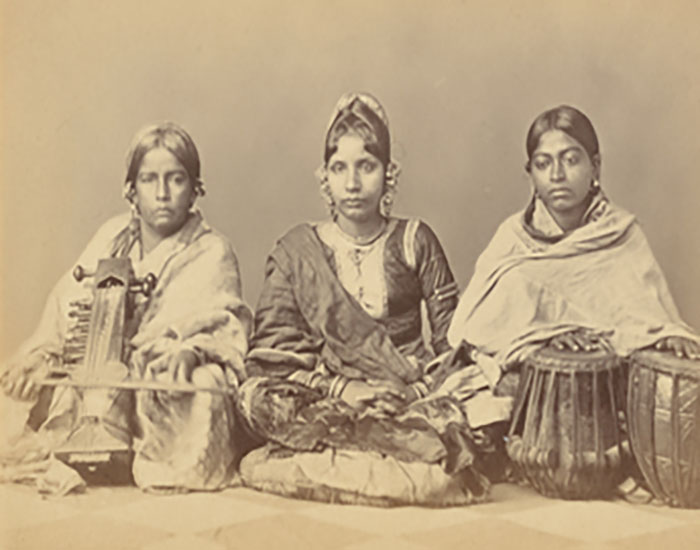Encyclopedia of Art > Articles
The Beauties of Lucknow

A photographic album published in 1874 in Calcutta (now Kolkata), The Beauties of Lucknow consists of twenty-four portraits of women employed in the court of the princely state of Awadh (or Oudh). Although unsigned, the photographs and authorship of the book have been attributed to the Indian photographer Darogah Abbas Ali, who has also provided separate handwritten introductions in English and Urdu in the respective editions, suggesting an aesthetic link to the Mughal muraqqa tradition of illustrated albums. The full title of the album, as it appears in the English edition, is The Beauties of Lucknow Consisting of Twenty-Four Selected Photographed Portraits, Cabinet Size, of the Most Celebrated and Popular Living Histrionic Singers, Dancing Girls, and Actresses of the Oudh Court and of Lucknow. The Urdu edition was titled Haseenain-e Lucknow.
In 1856, the kingdom of Awadh was annexed by the British East India Company, which argued that it was being ruled poorly by Wajid Ali Shah, a king known for his patronage of the arts, and of theatre and courtesan culture in particular. Despite their denunciation of the King, they continued to hold a fascination with his legendary court, prompting them to engage a photographer to capture and preserve the vitality and mystic appeal of royal courtly entertainment for posterity, in the form of a photographic album. The book features individual portraits of singers, courtesans, dancers and actors — multiple roles were often assumed by a single performer who was known as a tawaif — at the Lucknow court, with a particular emphasis on those who regularly enacted the popular Urdu work Indar Sabha. The two different introductions reinforce ideas of oriental luxury for the British public in the mainland while providing material memories of a gloried past for the Indian elite. It is believed that Ali attempted, through these albums, to advance the Indian cultural ethos (especially regarding women courtesans) as an alternative to the prevailing Victorian model.
Photographs in The Beauties of Lucknow appear to have been taken in a studio setting and were printed in a cabinet card format (15 x 10.9 cm) as albumen prints and hand-pasted into the five albums. The larger size is all the more notable because the women’s faces are uncovered in all the images — something considered inappropriate, especially for Muslim women, at that time. It is believed that each copy of the book was intended to be treated like an item of luxury, as the photographs were hand-pasted and often unique to their respective editions.
In both the title and the introduction to the book, Ali suggests that the women photographed in 1874 were already well-known performers who held a high status, although none of them were the original courtesan performers of Wajid Ali Shah’s court when he ruled eighteen years prior. Across the five extant editions, one finds that while the women photographed are the same, they are each shown in slightly different poses and angles depending on the edition, suggesting that Ali captured and printed multiple shots from each session with his sitters.
It is known that following the annexation of Awadh, the tawaifs of the former king’s court, who had some of the highest incomes in the city and exerted much cultural influence, either fled or accompanied the king into exile, while subsequent performers lived in relative impoverishment under the new Victorian moral code. Therefore, despite its mandate to reenact history, the project could only go so far as to reimagine a lost era with the only remaining actors at its disposal. A later comparison of surviving copies of the book further revealed that some of the same women appeared under different names, possibly due to shuffling as a result of loose fixture, confounding claims to historical accuracy. Nonetheless, the album is universally acknowledged as one of the earliest products of a centuries-long popular fascination with the tawaifs of Indian courts.
Photographs from The Beauties of Lucknow are housed in the George Eastman Museum, New York, USA; the Victoria and Albert Museum, London, UK; among the artist Amit Ambalal’s personal collection in Ahmedabad; the New York Public Library, USA; the Museum of Art and Photography (MAP), Bangalore; and the Alkazi Collection of Photography, New Delhi, which holds the only Lucknow-published and Urdu edition of the book.
First Published:
Last Updated: July 26, 2023

